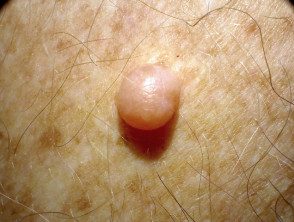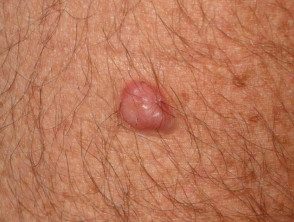What is a solitaire? cutaneous neurofibroma?
A solitary cutaneous neurofibroma is a common nerve sheath tumor. Presents as a skin color, soft to firm papule or nodule With a smooth surface. Typically, pressing the injury With a finger he makes it fold so that the outer surface becomes an inner one, a maneuver called “eyelet invagination.”
Solitary neurofibromas

Solitary neurofibroma

Solitary neurofibroma

Solitary neurofibroma
Who gets solitary neurofibroma?
Neurofibroma is usually diagnosed in young adults. As neurofibromas persist, they can also be diagnosed in older or younger people. It is equally predominant in both sexes
Solitary neurofibroma must be distinguished from genetic disorder neurofibromatosis, in which there are multiple neurofibromas, café au lait macules, and other features.
What are the risk factors for solitary neurofibroma?
No definitive risk factors have been identified for solitary neurofibroma, which is not inherited.
What is the cause of solitary neurofibroma?
The cause of solitary neurofibroma is unknown.
What are the clinical characteristics of a solitary neurofibroma?
Solitary neurofibroma usually arises in the second or third decade of life and will be located on the skin of the head and neck, trunk or proximal Tips Features are:
- a soft flaccid or rubbery, dermal or subcutaneous, asymptomatic papule or nodule
- A pedunculated lesion that arises below the surface of the skin
- 2–20mm diameter
- Pinkish-white to dark brown, usually similar to normal skin color.
How is solitary neurofibroma diagnosed?
The diagnosis of solitary neurofibroma may be suspected by its typical clinical features, in the absence of significant signs and symptoms of neurofibromatosis. A neurofibroma has no features on dermoscopy, which distinguishes it from smooth-surface dermal skin. nevus, (which usually shows some areas of pigmentation)
Please note that a solitaire plexiform Neurofibroma, which primarily presents as a pouch-like mass on the trunk or proximal extremities, is pathognomonic for neurofibromatosis type 1.
Skin biopsy can be carried out; the pathology neurofibroma is a diagnosis.
What are the possible complications of neurofibroma?
Unlike neurofibromatosis, any concerns about solitary neurofibroma are purely cosmetic.
What is the treatment for solitary neurofibroma?
Solitary neurofibroma is a benign tumor and rarely requires any treatment. If there is discomfort, diagnostic uncertainty or cosmetic problems, it can be removed surgically.

